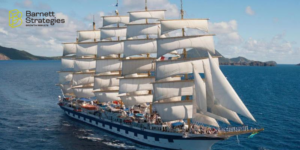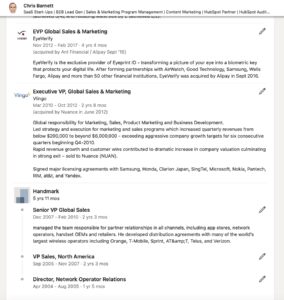How To Keep Winning: A Q&A About Taking Your Company to the Next Level

Running a successful business is, well…busy! Like a coach during March Madness, you’re locked in, focused on the day-to-day, bringing in the next customer, and keeping your in-game strategy running smoothly. Your company has a viable product and you’re getting some good traction and enthusiasm. The feedback is great, but you’re still not seeing a lot of sales yet. How do you take it to the next level and start ramping up sales? This is a question we get a lot from clients, particularly in the early stages. So what’s the answer? Our very own Chris Barnett sat down for a quick Q&A about this topic, including his own experience with some now major players like Handmark, Vlingo, and EyeVerify. Let’s dive in:
Q: How do early-stage companies increase sales and get to that next level? What’s the missing ingredient?
A: What’s often the biggest missing ingredient is the Flagship Customer. That gigantic, early-adopter who will not only be a paying customer but also give you publicity and collaborate with you on the missing pieces to make your product a slam dunk. Often it’s the final go-to-market steps — which are neither obvious nor easy — that can be the most difficult to accomplish. Whether it’s because you’re not sure what they are or if they’re important, or if it’s difficult to motivate your team, having a flagship customer will help push your company to get it done.
Q: What qualifies as a flagship customer? What should you be looking for?
A: This customer is going to be very different from your first customer — or even your first three customers, who are usually smaller companies. What you’re looking for is that gigantic, game-changing customer. Typically that flagship customer is an early adopter. They likely will have a venture team or corporate development department that may want to invest in your small company as well as be a paying customer. Often it’s the vision of this venture or corporate development team that’s a key ingredient in driving what’s next — the early adopter mindset.
Q: Okay, so isn’t it obvious that any company would like to have this gigantic customer that’s going to get them extra publicity?
A: You’re likely thinking “well, of course we want this giant customer that lights up the world and tells everyone about us!” But the truth is it’s NOT always obvious. And it comes down to strategy. If you’re busy chasing ordinary customers, you’re missing out on opportunities to get that giant flagship customer. The time you’re spending with those 50 potential medium or small customers is time you could be spending finding your SUPER CUSTOMER. Simply put, it’s hard to sell to big companies. Getting that flagship customer on board is going to require a ton of time, lots of meetings and conversations, flexibility to move your schedule around to accommodate theirs… not to mention that you’ll need to have multiple of these big companies in play in order to land just one. But it’s important to prioritize this process and get that flagship customer in order to take your company to the next level.
Q: How do you know this strategy of getting the “flagship customer” really works?
A: Let me give you some examples from my own experience to show you how getting that flagship customer is the slam dunk to propel your company to the next level.

Handmark | Flagship Customer: Sprint (now T-Mobile)
At Handmark, we had a successful new product for smartphones called Pocket Express. It had won awards, we had adoption, we already had paying subscribers and enterprise customers — but in order to really go bigtime and become a $50 million company, we needed a flagship customer. Enter Sprint. At the time, Sprint was an early adopter in mobile. They helped us make changes to the product that we didn’t completely realize were absolutley necessary. They pushed us to work smarter and faster with quick deadlines and an ambitious timeline. And while we raised some valid concerns about speeding up the pace, ultimately it came down to “you gotta do what it takes.” I remember one of the Sprint executives addressing our team’s concerns: “The problem here is your team doesn’t fully understand the insane level of effort required to get smartphones in the market.” And this was essentially our “aha” moment. So we got to work and got it done. Was it easy? No. Executing what the flagship customer wants is beyond difficult because they set the bar really high. Was it worth it? Absolutely. We made the deadlines, they deployed the product, we had millions of users, and Handmark became a $50 million per year revenue company.
Vlingo | Flagship Customer: Samsung
At Vlingo, we had a product that was like Siri, but even better. So, in the name of competition, Samsung was interested in Vlingo primarily in response to Apple’s Siri. They had already been working with us, and having invested, they were interested in doing more. And in this case as well, they demanded extraordinary things from our team. I remember getting ready for Mobile World Congress in Barcelona, meeting with Samsung, and they asked for changes to the software. Here we are a day and a half before the start of the trade show — Saturday morning in Barcelona, but 2 a.m. in Boston — and they want these changes done by Monday morning. Did it matter that it was the weekend? Nope. So, I woke up the CEO and we got the engineering team out of bed in the middle of the night and everyone got to work. This, of course, is not something we would have done in the ordinary course of things, but with a flagship customer like Samsung, you do what it takes. I can think of multiple other similar stories with short deadlines made even more difficult with the difference in time zones, but ultimately, this led to incredible success — we had a huge launch, brought in lots of revenue, and ended up being bought by a giant company in the same space.
EyeVerify | Flagship Customer: Alibaba Group/ Alipay
You’re likely starting to see a pattern here. Let’s keep it going… At EyeVerify, again we had a great product, we had some bona fide paying customers, but we weren’t enormous in the space yet. EyeVerify (now rebranded as ZOLOZ) is a biometric security technology company offering a biometric verification solution for mobile devices. This may not be as detailed of an anecdote, but it fits the bill just the same. Alipay’s ask? We need you to support 450 million users. This was a mind-blowing scale for us at the time, something we would have never even thought through without a customer demanding it. But again, we pushed through the difficulties and made it happen. Alibaba Group’s Ant Financial went on to acquire EyeVerify later that same year with plans to integrate the technology into more of its products. Today, Alipay has about 1.3 billion users worldwide and was the leading mobile payment platform in 2022.
As you can see, all of these examples follow the same strategic game plan. We had viable products and good traction, but not enough sales. The game-changer? In each case, it was the flagship customer that invested and helped push the pace, raising the bar to get the most out of the products and ultimately launching each of these companies to the next level — making them major players in their respective spaces.
If you want to keep winning and take your company to the next level, take a look at your strategy and make a game plan to find and land that flagship customer. Is it going to be time-consuming and a lot of work? Yes. Will it be easy? No. Is it worth it? Absolutely. And if you need an experienced “coach” in your corner to help you find that game-changing flagship customer — reach out to us and let’s find the alley-oop to your slam dunk… Don’t worry, we’ll try to keep the basketball puns to a minimum! 😉

